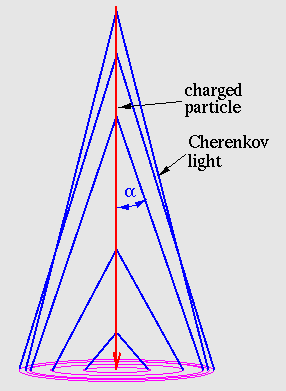
Charged particles moving through the atmosphere with a velocity larger than
the local speed of light (the vacuum speed of light divided by the
refractive index of the air) emit
Cherenkov light.
This light is
emitted on a narrow cone around the direction of the particle.
The opening angle alpha is a function of the density of the air and,
thus, of the height of emission. It is increasing downwards but is always
less than about 1.4 degrees. From each part of the particle track
the Cherenkov light arrives on a ring on the ground.
In an air shower, the initial particle interacts with the air atoms,
producing many new particles. Most of those particles will be stopped
or decay before they reach the ground. The Cherenkov light of all those
shower particles faster than the local speed of light overlaps on
the ground.
Note: different transliterations are in use for the name of the
Russian physicist, who (together with Vavilov) discovered the nature
of this kind of light emission in 1934: Cherenkov or Cerenkov
or Čerenkov.
(Sorry, but the last variant does not display properly with some browsers.)
In the literature, the effect is sometimes called the Vavilov-Cherenkov
effect.
The first to realize that cosmic-ray air showers would produce enough Cherenkov light to be detectable was Blackett in 1948 and the first to detect this light were Galbraith and Jelley in the early 1950s. Although there are also other ways to detect air showers, the Cherenkov method has the lowest energy threshold now. In the 1950s and 60s Cherenkov light was used to study properties of air showers induced by cosmic rays (protons and heavier atomic nuclei). Starting at about 1970, Cherenkov telescopes (for example the Whipple Gamma-Ray Telescope) were used to search for sources of TeV energy gamma rays. Although first detections were reported in the 1970s, it was not before 1988 when the imaging technique provided a means to distinguish between cosmic-ray induced air showers (coming from all directions) and gamma-ray induced air showers. Only gamma rays, being responsible for a tiny fraction of all air showers, travel on straight lines through our Galaxy and can be used to image sources of such high-energy particles. For detecting an enhancement of gamma-ray showers from a source direction above the isotropic background of cosmic rays, the rejection of cosmic-ray showers is of crucial importance.
There are basically three ways to distinguish between cosmic-ray
and gammay-ray induced air showers: different image shapes with
imaging telescopes, different distributions of the light arriving
on the ground, and different distributions of arrival times of
the Cherenkov photons.
The best cosmic-ray rejection is now achieved with stereoscopic
systems of several Cherenkov telescopes, as pioneered with the
HEGRA telescope system.
Stereoscopic here means that several telescopes view the same
showers from different angles.
Current instruments using this technique include
H.E.S.S.,
MAGIC,
VERITAS,
and others.
To get an impression how the distribution of Cherenkov light of air showers looks like on the ground and in potential telescopes used for imaging this light, go to the Cherenkov light simulations.